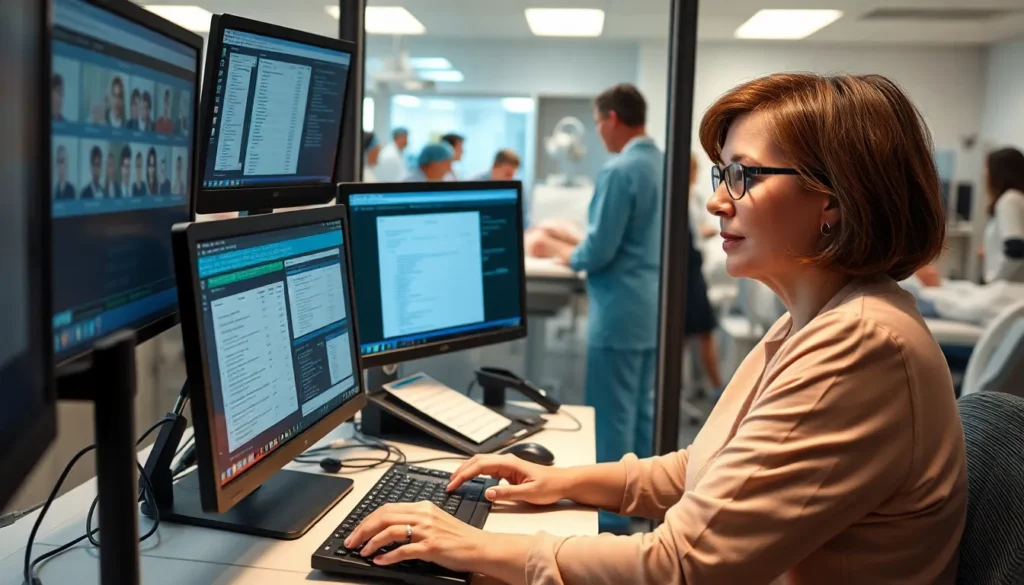Table of Contents
ToggleIn the world of healthcare, procedural coding is the unsung hero that keeps everything running smoothly. Imagine a chaotic hospital where doctors and nurses are shouting medical jargon left and right. Now picture a calm oasis where every treatment and procedure is neatly categorized. That’s the magic of procedural coding. It transforms complex medical services into a universal language that insurance companies understand, ensuring providers get paid for their hard work.
Overview of Procedural Coding
Procedural coding serves as a systematic approach that classifies medical services into standardized codes. This classification enables effective communication among healthcare providers, insurers, and patients. Standardized codes streamline the billing process and ensure appropriate reimbursement for services rendered.
Coding schemes like Current Procedural Terminology (CPT) and the Healthcare Common Procedure Coding System (HCPCS) represent the backbone of procedural coding. CPT codes, for instance, categorize a wide range of medical, surgical, and diagnostic services, facilitating uniform understanding across the healthcare spectrum. HCPCS expands on this by including codes for various supplies and services not covered by CPT.
Healthcare providers benefit significantly from procedural coding by minimizing billing errors and enhancing claim approvals. Training staff in coding procedures optimizes workflow and ensures compliance with regulations. Accurate coding reduces the risk of audits and penalties, contributing to better financial health for medical facilities.
Patients experience more transparency regarding their medical expenses due to procedural coding. Clear billing statements clarify what services were performed and the associated costs. Navigating insurance claims becomes more manageable, improving the overall patient experience.
Effective procedural coding not only enhances operational efficiency but also maintains the integrity of patient records. Proper documentation supports quality care and aids in legal compliance within the healthcare landscape. Thus, procedural coding emerges as a vital function that underpins successful healthcare delivery and financial viability.
Importance of Procedural Coding

Procedural coding plays a vital role in modern healthcare systems. It ensures an organized approach to classifying medical services, thereby enhancing communication among stakeholders.
Impact on Healthcare Billing
Healthcare billing relies heavily on procedural coding. Accurate coding directly influences reimbursements, as insurers depend on correct codes to process claims. A well-coded claim reduces the chances of denial, expediting payments to providers. In turn, this efficiency allows healthcare facilities to maintain operational stability. Furthermore, it minimizes discrepancies, resulting in fewer billing errors that could frustrate patients and providers alike. Consistent application of standardized codes creates a predictable billing environment, fostering trust between healthcare providers and insurers.
Role in Medical Documentation
Procedural coding significantly impacts medical documentation. Each coded service provides a clear description of the treatment rendered, which benefits both clinical teams and patients. Detailed coding maintains comprehensive patient records, ensuring accurate information is accessible for ongoing care and future referrals. Clear documentation supports adherence to regulatory requirements, protecting providers against legal challenges. Additionally, it facilitates data sharing across healthcare platforms, enhancing continuity of care. Overall, robust coding practices contribute to improving patient outcomes by ensuring that all services are precisely tracked and reported.
Types of Procedural Coding Systems
Various procedural coding systems help organize and standardize medical services. Each system has unique applications and relevance in healthcare settings.
CPT Coding
CPT coding, or Current Procedural Terminology, provides a comprehensive classification for medical procedures and services. Developed by the American Medical Association, it covers thousands of codes, which healthcare professionals use to report and bill for services. Categories within CPT coding include evaluation and management, surgery, radiology, pathology, and laboratory services. This coding system increases billing accuracy, streamlines reimbursement processes, and ensures consistent communication between providers and insurers. Overall, CPT coding supports efficient healthcare administration and maximizes revenue potential.
HCPCS Coding
HCPCS coding, or Healthcare Common Procedure Coding System, offers a coding framework that complements CPT. This system features two levels: Level I consists of CPT codes, while Level II addresses non-physician services, such as ambulance services and durable medical equipment. HCPCS enhances healthcare transactions by providing specific codes for items not covered under CPT, allowing providers to receive appropriate reimbursement. Moreover, this coding system supports compliance with Medicare and Medicaid billing requirements, ensuring that providers navigate the complexities of healthcare programs effectively.
ICD Coding
ICD coding, or International Classification of Diseases, focuses on diagnosing conditions rather than procedural services. This coding system tracks disease prevalence and healthcare outcomes, providing essential data for public health initiatives. Healthcare providers utilize ICD codes to describe patient diagnoses accurately. Updated periodically, the ICD-10-CM version introduces thousands of codes to ensure comprehensiveness. Accurate ICD coding affects reimbursement rates and aids in understanding healthcare trends, making it a crucial element of procedural coding within the healthcare system.
Best Practices in Procedural Coding
Understanding best practices in procedural coding ensures accurate communication and efficient billing in healthcare. Adopting these guidelines can lead to improved outcomes for both providers and patients.
Accuracy and Compliance
Maintaining accuracy in procedural coding significantly impacts reimbursements. Coders must follow specific coding guidelines and updates to avoid errors. Compliance with regulations supports legal standards and mitigates the risk of audits. Regular training ensures coders stay informed of changes in coding systems. Utilizing resources like the American Medical Association’s CPT guidelines reinforces accuracy and compliance efforts. Coders must routinely review their work to confirm consistent application of coding protocols. Adherence to these practices ultimately secures timely payments and enhances the reputation of healthcare providers.
Tools and Resources for Coders
Using the right tools enhances the efficiency of procedural coding practices. Various coding software programs streamline the coding process and reduce errors. Online coding databases provide instant access to current codes and updates. Professional organizations, like the American Academy of Professional Coders, offer resources and training. Utilizing coding apps can aid coders in staying organized and keeping track of changes. Workshops and webinars further enhance knowledge and skills through real-time learning. Coders benefit from sharing insights and experiences via forums and online communities, creating a supportive network for professional growth.
Challenges in Procedural Coding
Procedural coding presents various challenges that can affect accuracy and efficiency in healthcare billing. These challenges include frequent errors and ongoing changes in coding standards.
Common Errors and Solutions
Common errors in procedural coding often stem from incorrect code selection, data entry mistakes, and misunderstanding of guidelines. Coders may choose incorrect codes, leading to claim denials or delays in payment. To address these issues, regular training and utilization of coding resources significantly reduce mistakes. Implementing systematic checks before submission alerts coders to potential errors. Collaboration among coders, insurers, and healthcare providers fosters a more accurate coding environment, minimizing discrepancies.
Keeping Up with Changes in Coding
The healthcare industry experiences frequent updates in coding systems like CPT and HCPCS, with new codes and guidelines introduced annually. Keeping up with these changes requires dedication from coders. Subscription to coding newsletters and membership in professional organizations enhances awareness of updates. Attending workshops and online seminars provides insight into the latest practices and standards. Coders who adapt swiftly ensure compliance and maintain accuracy in their work, ultimately benefiting healthcare operations.
Procedural coding stands as a cornerstone in the healthcare industry. Its structured approach not only streamlines billing and enhances communication but also supports the integrity of patient records. By adhering to best practices and staying updated on coding standards, healthcare providers can minimize errors and ensure timely reimbursements. This commitment to accuracy fosters trust among providers, insurers, and patients alike. As the healthcare landscape continues to evolve, the significance of procedural coding will only grow, reinforcing its role in delivering efficient and effective care.







